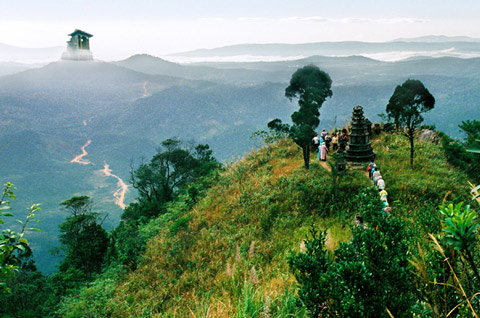Beauties and Wonders Beyond Yen Tu

Every year, the Yen Tu Mountain is flocked by tens of thousands of pilgrims to begin their journey to the uppermost shrine. Known as the Buddhist capital of Vietnam, the mountain is popular for its breathtaking landscapes, historical relics and ancient pagodas, thus continuously attracting visitors that add up to the large crowd that stream toward the top.
Seasoned hikers or for those who are up for a challenging outdoor adventure, reaching Yen Tu’s peak requires a 1,600-meter trek. It may sound like a lot of work, but the spectacular scenery that unfolds as you ascend higher can make it worth the while apart from the unique experience which many considers an equally important reward.
To the relief of those who are not so keen about climbing those rock-made steps and through the bamboo and pine tree forests, they have the option to take the cable car that carries tourists up to Hoa Yen Pagoda, and from there they can continue to explore the sights and hike up to the peak. With that, there isn’t really much of the beauty that is missed.
With the huge attention Yen Tu is getting, some travelers have missed out on some more pleasant surprises should they choose to veer slightly off the beaten path and explore the west side of the holy mountain. Here, you will pass by several pagodas, waterfalls and streams besides century-old as you make your way to the mountain top in the districts of Yen Dung, Son Dong, Luc Ngan and Luc Nam in Bac Giang Province.
Mo Stream
The west side, covering nearly 100 kilometers, is also home to many cultural and historical works, especially those which were built during the Ly (1010-1225) and Tran (1226-1400) dynasties. Located at Nghia Phuong Commune, Luc Nam District is Mo Stream. This beautiful stream winds through a valley between Huyen Dinh and Yen Tu mountains and with three temples that can be found along the stream: the Thuong (Upper), Trung (Middle) and Ha (Lower). According to folktales, these temples were said to be built during the 10th century Le dynasty in honor of Princess Que My Nuong, the daughter of King Hung XVI.
Many sections of the stream turn into small and big waterfalls, including Thum Thum, the highest of them all. Quite a little distant, Thum Thum is located along the winding 3.5 km road from the Thuong temple, through the Suoi Mo lake project. But all the hard work one has to take to get there will be washed away as the magical beauty of Thum Thum unfolds.
Thum Thum Falls
Thum Thum, starting from the top of Huyen Dinh Mountain some 100 meters high, falls in four stages with each of them having its own unique attraction. As its water pours down from above, it creates a wonderful natural bath and drum-like sounds, of which where it was named after. The water is very pure and cool. The flora is highly developed and rich diversity of forest trees emerging to cover the stream.
At the first stage are inviting bathtubs-like ponds naturally created from the cascade and rocks. The second level was named Tron (slippery) Waterfall because of its challenging and slippery path. The third level exudes it own unique and calm beauty. Here, the water is noticeably clean and pure that even the tiniest pebble on the bottom could be seen.
Pretty much an obstacle course to make it to the top, reaching the highest level would take some crossing through humongous rocks and a forest. Yet the immaculate feeling of being on the peak and sweet echoes from the water rushing down will soothe all the exhaustion away.
Nuoc Vang Stream
One of the most famous “assets” of Luc Nam is the Nuoc Vang (golden water) Stream that runs along Phat Son Mountain, between 800 and 900 meters above the sea level. The road leading to the stream is meandering and curved. The stream has its name from the color of its water which is honey-yellow throughout the year. Such color is believed to be caused by a giant coal mine in Quang Ninh Province or the disintegration and agglomeration of trees over thousands of years. Every summer, the bright yellow fades. Every winter, it darkens. Many locals also believe that the water picks up its tinge as it flows through yellow sandstone. Until present, however, no one has settled on a satisfactory explanation on this. Just don’t be fooled as this bizarre-colored waters are as clean and pure as you can hope to find anywhere in the country. For generations, water drawn from the spring has sustained the livelihoods of many local Vietnamese families living around the area.
Giot Waterfall
At the top of Nuoc Vang is the 50-meter-high Giot Waterfall where you can have an undisturbed, pleasant view of the enchanted stream. The road to get there is rocky. Reaching the falls is a reward in itself. Watching the stream at Ba Giot Waterfall flows through rapids and pours over the edge in three falls, which are best viewed from upstream if you want to capture their full grandeur and beauty. Pedal-boating on the quieter reaches of the water, as well as camping, are available at the waterfall.
Nearby the waterfall is Ba Chong Stone. After millions of years of rain and sunshine, being covered by the sea three times and witnessing hundreds of severe volcanic eruptions, the three layers piled up on each other unsteadily and formed an impressive landscape.
Not far from Ba Chong Stone, two Bach Tuong hills look like a pair of elephants. On the top is Thich Ca statue sitting on a lotus base while at the bottom is a deep cave and Thien Chon pagoda.
Ba Chong stone rooting from the Oc Eo-Phu Nam civilization in the southeast highland terrace has been listed by the Ministry of Culture and Information since 1998.









